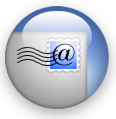
Direct Mail
Company: e3 Software
Price: Direct Mail Basic $59.99 – Direct Mail Pro $119.99
http://ethreesoftware.com/directmail/
Do you send out bulk emails? How about a newsletter or flyer to small or large groups of email addresses? Trying to manage this with Apple’s Mail program, or other mail programs, can be tough.
Today we’ll look at bulk mailing program Direct Mail which offers mailing list management and unique tracking capabilities for the Mac.
At RichLefko.Com, I watched as my mail list grew to 100, 200 then 300+ people. If you are already trying to manage a list bigger than 25 or 30, that is growing, you know just how difficult that can be. Adding, deleting, and adjusting addresses, can be an enormous time sink.
There are two versions of Direct Mail: Direct Mail basic, and Direct Mail Pro. This review covers the Pro version, however, I will be discussing the differences between the two programs throughout this review.
Getting addresses into Direct Mail Pro is fairly simple. You can type in addresses manually or you can import mail addresses from your Apple address book, Microsoft’s Entourage, or from a CSV file. I had at least 200 addresses in a Gmail account. I was able to convert over 200 email addresses by first exporting them as a .csv file and then importing them into Direct Mail Pro. There are many options for creating subscription groups, address groups, and blacklists. Direct Mail Pro is very versatile when it comes to organizing your addresses.
With Direct Mail Pro you can also set up automated subscription lists that work very well. This feature alone is worth the price of the program. You can design your own subscription form, or use the one provided.
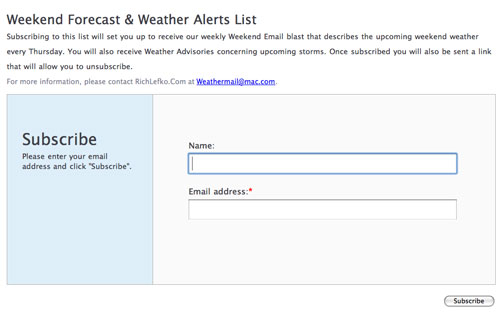
Set up a subscription group within Direct Mail Pro and you get two URLs, one to subscribe and one to unsubscribe. You insert this link into emails, web pages, etc. When someone clicks on the link the subscription form pops up and the subscriber types in their name and email address and clicks the subscribe button. A confirmation email is then sent to the potential subscriber’s email box where they click on a supplied link and that address is added to your automated subscription group within Direct Mail Pro. Subscribers are also shown an “unsubscribe link†they can click on in the future to be removed from the list.
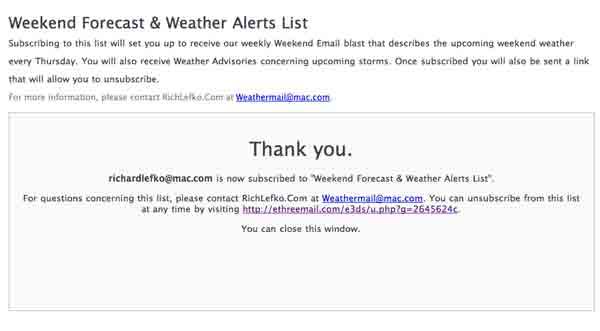
If you manage hundreds, or thousands, of email addresses you will find automated subscription groups to be a priceless feature. Also, for people who fear signing up for subscriptions because they worry about who might see their email address, you can alleviate their concerns because their email address comes directly to you and is not sent to some third party.
Creating email messages, or templates, is also fairly easy. You can include graphics and/or html within your message. Unfortunately, there are no tools within Direct Mail Pro that will help you size or format a graphic. When formatting your message, you have access to all of your fonts, and you can use background colors or embed video, flash, and javascript. The experience is similar to designing a web page. The folks at e3 will tell you adding video and flash to an email message is a bad idea because you don’t know the capabilities of the email client you may be sending to. In fact, you can import the body of a web page and send it as an email message by simply supplying the URL. I found this to be a cool feature because all of the links within the page work in the message. However, I’m not sure of its usefulness.
After creating a message you can use the send button in conjunction with an email list you’ve created to mail it. This is where we see the real power in Direct Mail Pro. You can use your own mail-server to send out the message or you can use e3 Software’s mail service. More on this in a moment. You can select entire mail lists, or just a few mail addresses to send to. Once your message is sent, you can review a number of delivery statistics about that particular message.
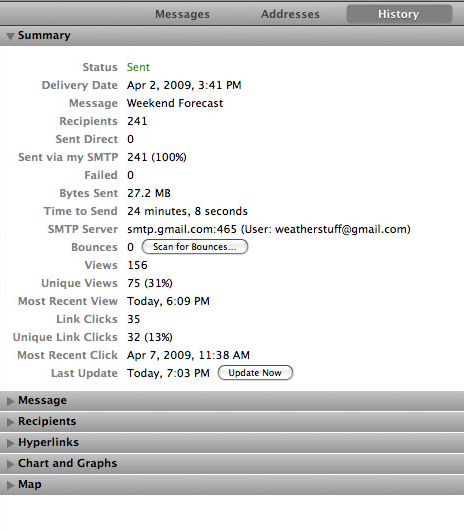
With Direct Mail Pro, you can track the delivery history, if your message was read, and if it included hyperlinks, which ones were clicked and how many times. You can even tell if your message was bounced and test your message against junk mail filters before you send it. If you’ve sent to less than 750 people, Direct Mail Pro will even generate a Google type map with markers.
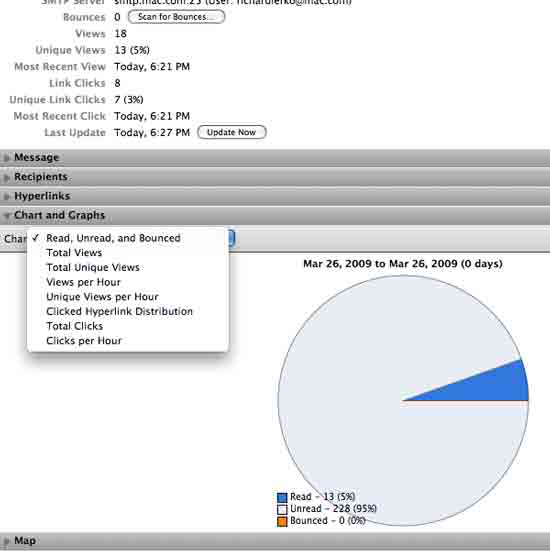
You can send messages three different ways. You can use your own ISP’s SMTP server. Set up is fairly simple. You enter email setting information into Direct Mail Pro and the program sends out your message using your ISP. This can be a slow process because Direct Mail Pro sends out one message to each recipient. For example, using this method, it took roughly 24 minutes to mail 250 messages. The speed is highly dependent on your Internet connection and your ISP which means the time it takes can be more or less.
The Pro version allows you to send your message directly to e3 where their delivery service takes care of the rest. This method took seconds to mail 250 messages. This is a paid service only available to Pro users.
When you buy Direct Mail Pro, you are given 10,000 complimentary email credits. Each time you send more than ten emails using the service, one credit is deleted for each email address. Send 1,000 emails using the service, use 1,000 credits. More credits can be purchased for one cent each ($.01) in blocks of 5,000. Email credits never expire and unused credits can be refunded at any time. You can purchase credits directly through the program’s preferences menu.
The final way to send a message is directly to a recipient, though e3 points out that a message sent in this fashion has a good chance of being flagged as SPAM because most mail servers will assume that email sent from a dynamic IP address (i.e. not a known ISP’s mail server) is junk mail. In addition, direct delivery can take an extended amount of time to complete.
This table shows the feature differences between Direct Mail and Direct Mail Pro:
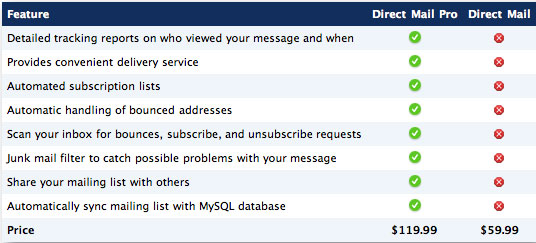
The design tools in either version are weak. I’d like to see the ability to alter and adjust images built into the program so you won’t have to leave the program to adjust your image. It would be great if Direct Mail Pro could remember frequently used URLs so hyperlinking would be more swiftly accomplished.
The general page layout can be a bit confusing at first. You create your emails in the column to the left, but there is no intuitive way to add another message without opening a new window. The goods folks at e3 suggested I just “duplicate†my last message. This works easily enough, but is not intuitive.
There is no manual to refer to. The only place to have your questions answered is the e3 website FAQ and support email. There are training sceencast type movies on the site, and these are a big help, but alas, there are only a few. A manual would be a very welcome addition.
The e3 delivery service in the Pro version works very well and I think the one cent charge is fair and reasonable, but I’d like to see larger discounts for high volume purchases.
The automated subscription services are highly developed, easy to use, and a breeze to set up.
I’ve only touched upon the many features available in Direct Mail Pro. Overall, this is a program worth owning if you send bulk email messages and have a large subscription base. However, folks with an address base of twenty-five or more would also benefit from Direct Mail. The fact that you don’t have to reveal your subscription list to a third party is a nice feature for security’s sake.
Direct mail is a great program for maintaining bulk email lists and the Pro version adds to the program’s usefulness in many ways. I would recommend the Pro version over the base version. I think this feature rich version is a better bargain than the base version.
This program has a very bright future.
email – MyMac Magazine – Twitter – Advertise – Reviews Archive – Podcast
